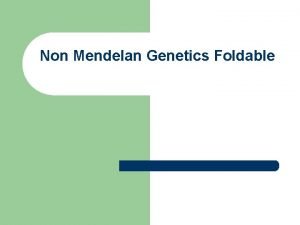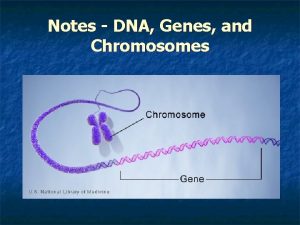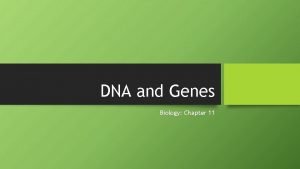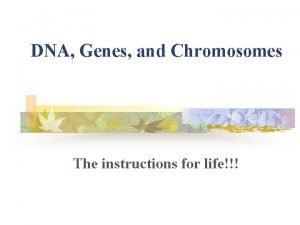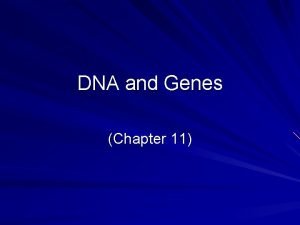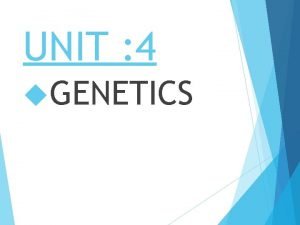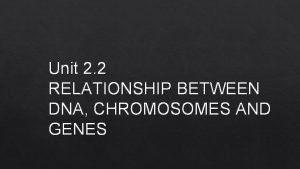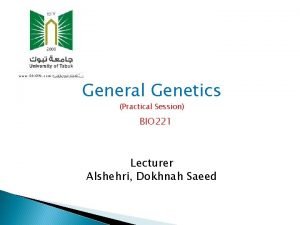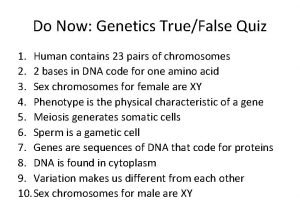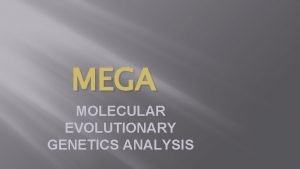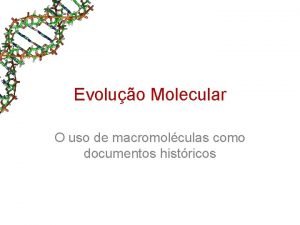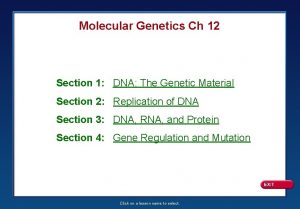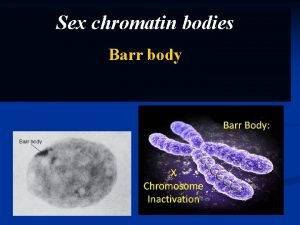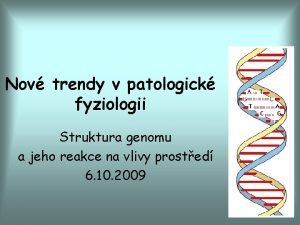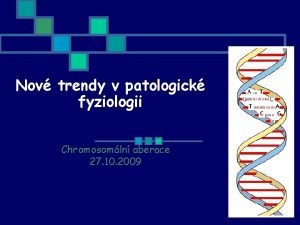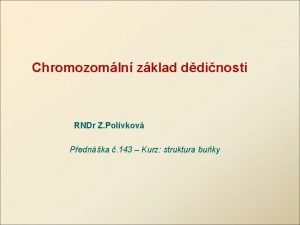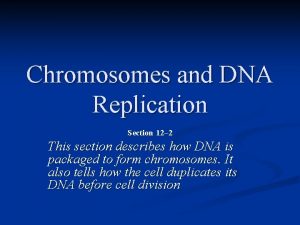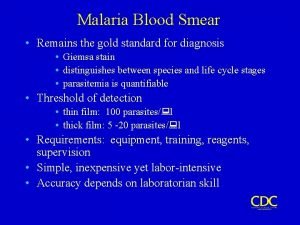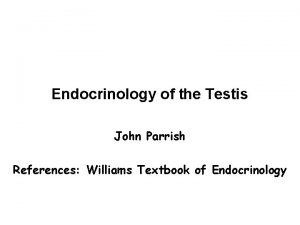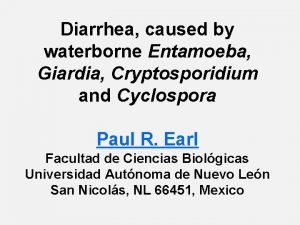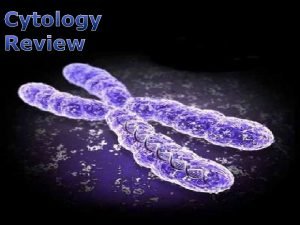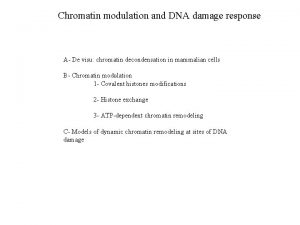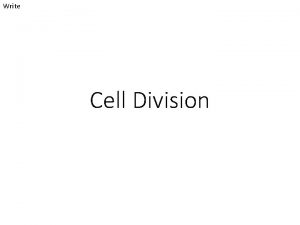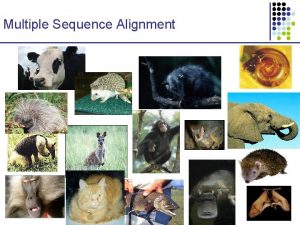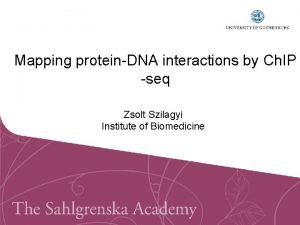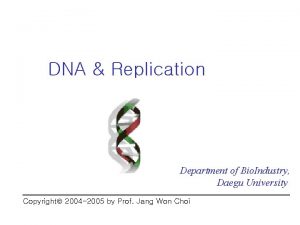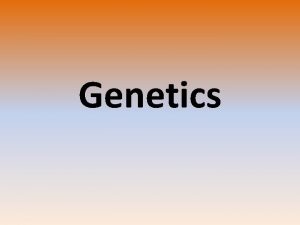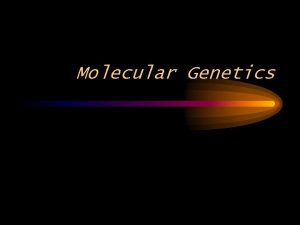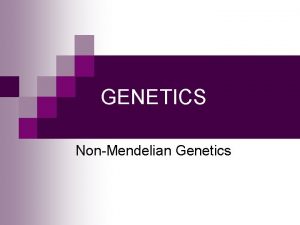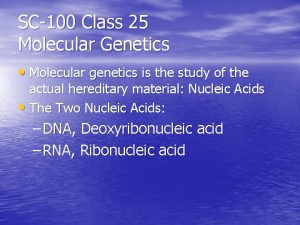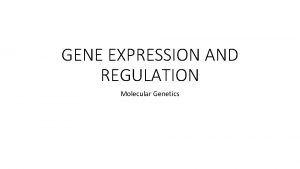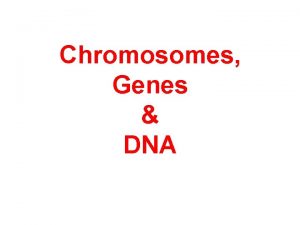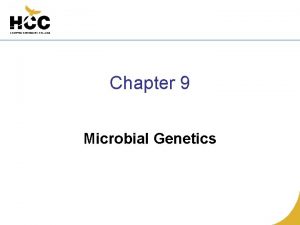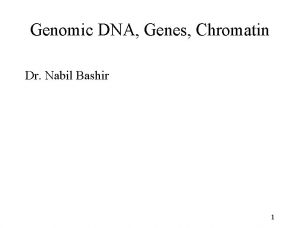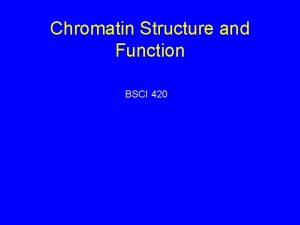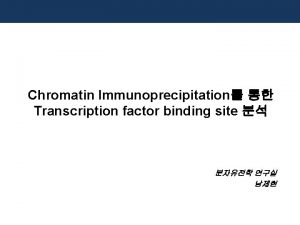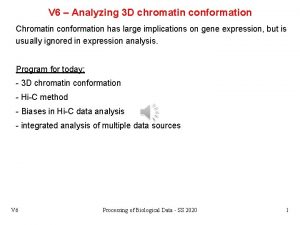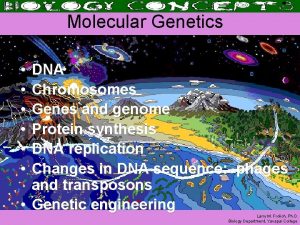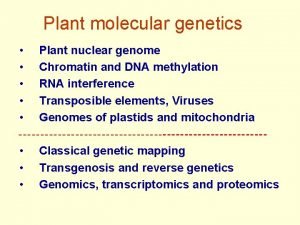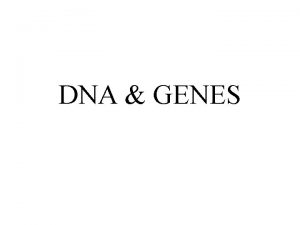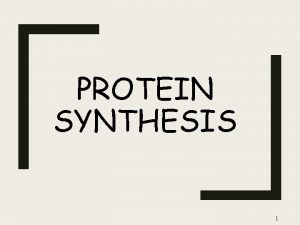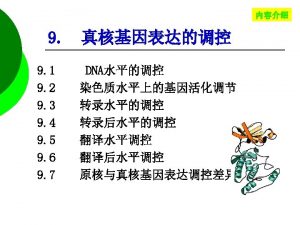MOLECULAR GENETICS CLASS SESSIONS 1 DNA Genes Chromatin




![Nucleoside [structure of deoxyadenosine] Nucleotide Nucleoside [structure of deoxyadenosine] Nucleotide](https://slidetodoc.com/presentation_image_h/80c0a8d50db0a8823c0b6c01fc1e14da/image-5.jpg)

































- Slides: 38

MOLECULAR GENETICS CLASS SESSIONS: 1. DNA, Genes, Chromatin 2. DNA Replication, Mutation, Repair 3. RNA Structure and Transcription 4. Eukaryotic Transcriptional Regulation 5. CLASS DISCUSSION – GENETIC DISEASES 6. RNA Processing 7. Protein Synthesis and the Genetic Code 8. Protein Synthesis and Protein Processing 9. CLASS DISCUSSION – GENETIC DISEASES 10. DNA Cloning and Isolating Genes

THE FLOW OF GENETIC INFORMATION DNA 2 RNA 3 PROTEIN 1 DNA 1. REPLICATION (DNA SYNTHESIS) 2. TRANSCRIPTION (RNA SYNTHESIS) 3. TRANSLATION (PROTEIN SYNTHESIS)

DNA Structure and Chemistry a). Evidence that DNA is the genetic information i). DNA transformation – know this term ii). Transgenic experiments – know this process iii). Mutation alters phenotype – be able to define genotype and phenotype b). Structure of DNA i). Structure of the bases, nucleosides, and nucleotides ii). Structure of the DNA double helix iii). Complementarity of the DNA strands c). Chemistry of DNA i). Forces contributing to the stability of the double helix ii). Denaturation of DNA

Structures of the bases Purines Pyrimidines Adenine (A) Thymine (T) 5 -Methylcytosine (5 m. C) Guanine (G) Cytosine (C)
![Nucleoside structure of deoxyadenosine Nucleotide Nucleoside [structure of deoxyadenosine] Nucleotide](https://slidetodoc.com/presentation_image_h/80c0a8d50db0a8823c0b6c01fc1e14da/image-5.jpg)
Nucleoside [structure of deoxyadenosine] Nucleotide

Nomenclature Base Nucleoside +deoxyribose Purines adenine guanine adenosine guanosine hypoxanthine inosine Pyrimidines thymine cytosine thymidine cytidine +ribose uracil Nucleotide +phosphate uridine

ii). Structure the Structure of theof DNA doublechain helix polynucleotide 5’ 3’ • polynucleotide chain • 3’, 5’-phosphodiester bond

A-T base pair Hydrogen bonding of the bases G-C base pair Chargaff’s rule: The content of A equals the content of T, and the content of G equals the content of C in double-stranded DNA from any species

Double-stranded DNA 5’ 3’ Major groove Minor groove “B” DNA 3’ 5’

Chemistry of DNA Forces affecting the stability of the DNA double helix • hydrophobic interactions - stabilize - hydrophobic inside and hydrophilic outside • stacking interactions - stabilize - relatively weak but additive van der Waals forces • hydrogen bonding - stabilize - relatively weak but additive and facilitates stacking • electrostatic interactions - destabilize - contributed primarily by the (negative) phosphates - affect intrastrand interstrand interactions - repulsion can be neutralized with positive charges (e. g. , positively charged Na+ ions or proteins)

Charge repulsion Stacking interactions Charge repulsion

Model of double-stranded DNA showing three base pairs

Denaturation of DNA Double-stranded DNA Strand separation and formation of single-stranded random coils Extremes in p. H or A-T rich regions high temperature denature first Cooperative unwinding of the DNA strands

Electron micrograph of partially melted DNA Double-stranded, G-C rich DNA has not yet melted A-T rich region of DNA has melted into a single-stranded bubble • A-T rich regions melt first, followed by G-C rich regions

Hyperchromicity Absorbance maximum for single-stranded DNA Absorbance maximum for double-stranded DNA 220 260 300 The absorbance at 260 nm of a DNA solution increases when the double helix is melted into single strands.

Percent hyperchromicity DNA melting curve 100 50 70 90 Temperature o. C • Tm is the temperature at the midpoint of the transition

Percent hyperchromicity Tm is dependent on the G-C content of the DNA E. coli DNA is 50% G-C 50 60 70 80 Temperature o. C Average base composition (G-C content) can be determined from the melting temperature of DNA

Genomic DNA, Genes, Chromatin a). Complexity of chromosomal DNA i). DNA reassociation ii). Repetitive DNA and Alu sequences iii). Genome size and complexity of genomic DNA b). Gene structure i). Introns and exons ii). Properties of the human genome iii). Mutations caused by Alu sequences c). Chromosome structure - packaging of genomic DNA i). Nucleosomes ii). Histones iii). Nucleofilament structure iv). Telomeres, aging, and cancer

DNA reassociation (renaturation) Double-stranded DNA Denatured, single-stranded DNA k 2 Slower, rate-limiting, second-order process of finding complementary sequences to nucleate base-pairing Faster, zippering reaction to form long molecules of doublestranded DNA

DNA reassociation kinetics for human genomic DNA % DNA reassociated Cot 1/2 = 1 / k 2 = second-order rate constant Co = DNA concentration (initial) t 1/2 = time for half reaction of each component or fraction 0 50 Kinetic fractions: fast (repeated) intermediate (repeated) Cot 1/2 slow (single-copy) Cot 1/2 100 I I I fast intermediate slow I I I log Cot I I I

106 copies per genome of a “low complexity” sequence of e. g. 300 base pairs high k 2 1 copy per genome of a “high complexity” sequence of e. g. 300 x 106 base pairs low k 2

Type of DNA % of Genome Features Single-copy (unique) ~75% Includes most genes 1 Repetitive Interspersed ~15% Interspersed throughout genome between and within genes; includes Alu sequences 2 and VNTRs or mini (micro) satellites Highly repeated, low complexity sequences usually located in centromeres and telomeres Satellite (tandem) 0 ~10% fast ~10% Alu sequences are about 300 bp in length and are repeated about 300, 000 times in the genome. They can be found adjacent to or within genes in introns or nontranslated regions. 2 intermediate ~15% 50 slow (single-copy) ~75% 100 1 Some I I I I I genes are repeated a few times to thousands-fold and thus would be in the repetitive DNA fraction

Classes of repetitive DNA Interspersed (dispersed) repeats (e. g. , Alu sequences) GCTGAGG Tandem repeats (e. g. , microsatellites) TTAGGGTTAGGG

Genome sizes in nucleotide pairs (base-pairs) plasmids viruses bacteria fungi plants algae insects mollusks bony fish The size of the human genome is ~ 3 X 109 bp; almost all of its complexity is in single-copy DNA. amphibians reptiles The human genome is thought to contain ~30, 000 to 40, 000 genes. 104 105 106 107 birds mammals 108 109 1010 1011

Gene structure promoter region exons (filled and unfilled boxed regions) +1 introns (between exons) transcribed region m. RNA structure 5’ 3’ translated region

The (exon-intron-exon)n structure of various genes histone total = 400 bp; exon = 400 bp b-globin total = 1, 660 bp; exons = 990 bp HGPRT (HPRT) total = 42, 830 bp; exons = 1263 bp factor VIII total = ~186, 000 bp; exons = ~9, 000 bp

Properties of the human genome Nuclear genome • the haploid human genome has ~3 X 109 bp of DNA • single-copy DNA comprises ~75% of the human genome • the human genome contains ~30, 000 to 40, 000 genes • most genes are single-copy in the haploid genome • genes are composed of from 1 to >75 exons • genes vary in length from <100 to >2, 300, 000 bp • Alu sequences are present throughout the genome Mitochondrial genome • circular genome of ~17, 000 bp • contains <40 genes

Alu sequences can be “mutagenic” Familial hypercholesterolemia • autosomal dominant • LDL receptor deficiency From Nussbaum, R. L. et al. "Thompson & Thompson Genetics in Medicine, " 6 th edition (Revised Reprint), Saunders, 2004.

LDL receptor gene Alu repeats present within introns 4 5 6 Alu repeats in exons unequal crossing over 4 Alu 5 Alu 6 X 4 Alu 5 Alu 6 one product has a deleted exon 5 4 Alu (the other product is not shown) 6

Chromatin structure EM of chromatin shows presence of nucleosomes as “beads on a string”

Nucleosome structure Nucleosome core (left) • 146 bp DNA; 1 3/4 turns of DNA • DNA is negatively supercoiled • two each: H 2 A, H 2 B, H 3, H 4 (histone octomer) Nucleosome (right) • ~200 bp DNA; 2 turns of DNA plus spacer • also includes H 1 histone



Histones (H 1, H 2 A, H 2 B, H 3, H 4) • small proteins • arginine or lysine rich: positively charged • interact with negatively charged DNA • can be extensively modified - modifications in general make them less positively charged Phosphorylation Poly(ADP) ribosylation Methylation Acetylation Hypoacetylation by histone deacetylase (facilitated by Rb) “tight” nucleosomes assoc with transcriptional repression Hyperacetylation by histone acetylase (facilitated by TFs) “loose” nucleosomes assoc with transcriptional activation

Nucleofilament structure

Condensation and decondensation of a chromosome in the cell cycle

Telomeres are protective “caps” on chromosome ends consisting of short 5 -8 bp tandemly repeated GC-rich DNA sequences, that prevent chromosomes from fusing and causing karyotypic rearrangements. Telomeres and aging Metaphase chromosome telomere centromere telomere structure telomere <1 to >12 kb (TTAGGG)many (TTAGGG)few young senescent • telomerase (an enzyme) is required to maintain telomere length in germline cells • most differentiated somatic cells have decreased levels of telomerase and therefore their chromosomes shorten with each cell division

Class Assignment (for discussion on Sept 9 th) Botchkina GI, et al. “Noninvasive detection of prostate cancer by quantitative analysis of telomerase activity. ” Clin Cancer Res. May 1; 11(9): 3243 -3249, 2005 PDF of article is accessible on the website
 Chapter 12 section 1 dna the genetic material
Chapter 12 section 1 dna the genetic material Linked genes and unlinked genes
Linked genes and unlinked genes Homeotic genes vs hox genes
Homeotic genes vs hox genes Linked genes and unlinked genes
Linked genes and unlinked genes Genetics foldable
Genetics foldable Genes chromosomes and dna
Genes chromosomes and dna Chapter 11 dna and genes
Chapter 11 dna and genes Dna, genes and chromosomes relationship
Dna, genes and chromosomes relationship Dna and genes chapter 11
Dna and genes chapter 11 Genes chromosome
Genes chromosome What is the relationship between dna chromosomes and genes
What is the relationship between dna chromosomes and genes What is agene
What is agene Dna genes
Dna genes Dna chromosomes genes diagram
Dna chromosomes genes diagram Dna rna protein synthesis homework #2 dna replication
Dna rna protein synthesis homework #2 dna replication 14-3 human molecular genetics
14-3 human molecular genetics Chapter 12 section 1: dna: the genetic material
Chapter 12 section 1: dna: the genetic material Chapter 12 molecular genetics
Chapter 12 molecular genetics Molecular evolutionary genetics analysis
Molecular evolutionary genetics analysis Parent genotype
Parent genotype Arvore filogenetica
Arvore filogenetica Chapter 12 section 1 the genetic material
Chapter 12 section 1 the genetic material Sex nn
Sex nn Chromatin vs chromozom
Chromatin vs chromozom Chromatin vs chromozom
Chromatin vs chromozom Chromatin vs chromozom
Chromatin vs chromozom Chromatin body
Chromatin body Chromatin in a sentence
Chromatin in a sentence Applique forms malaria
Applique forms malaria Chromatin
Chromatin Parasites
Parasites Chromatin draws together to create
Chromatin draws together to create Chromatin
Chromatin Phases of mitosis
Phases of mitosis Chromatin states
Chromatin states Chromatin immunoprecipitation
Chromatin immunoprecipitation Chromatin packing
Chromatin packing Covalently bonded substances
Covalently bonded substances Ionic covalent metallic
Ionic covalent metallic




